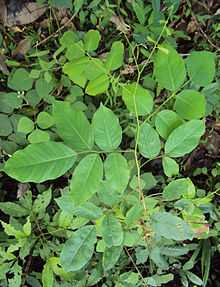Pterocarpus marsupium
| Pterocarpus marsupium | |
|---|---|
 | |
| Conservation status | |
| Scientific classification | |
| Kingdom: | Plantae |
| (unranked): | Angiosperms |
| (unranked): | Eudicots |
| (unranked): | Rosids |
| Order: | Fabales |
| Family: | Fabaceae |
| Subfamily: | Faboideae |
| Tribe: | Dalbergieae |
| Genus: | Pterocarpus |
| Species: | P. marsupium |
| Binomial name | |
| Pterocarpus marsupium Roxburgh | |
Pterocarpus marsupium, also known as Vijayasar or the Indian Kino Tree, is a medium to large, deciduous tree that can grow up to 30 metres tall. It is native to India, Nepal, and Sri Lanka, where it occurs in parts of the Western Ghats in the Karnataka-Kerala region. It is also known by the names Malabar Kino, Benga, Bijiayasal (in western Nepal), Piasal (Oriya[2]), Venkai, and many others.
Uses
Parts of the Indian Kino (heartwood, leaves, flowers) have long been used for their medicinal properties in Ayurveda. The heartwood is used as an astringent and in the treatment of inflammation and diabetes, for which it has been shown to be effective due to its high pterostilbene content.[3][4]. In vitro studies into the plant's anti-diabetic properties have also been carried out.[5]
Similipal Kol tribes in Odisha pound a paste mixture of the bark of P. marsupium with the barks of Mangifera indica, Shorea robusta and Spondias pinnata to treat some dysentery illnesses.[2]
In Karnataka the plant is known as Honne or Kempu Honne.Kannada people in India make a wooden glass (tumbler) from the heartwood of this herb (tree) and its aqueous solution is used to cure diabetes. Water is left overnight in the wooden tumbler and is consumed the following morning. The water draws healing properties from the wood overnight. The cup is made from the heartwood of the tree.
The gum resin of P. marsupium is the only herbal product ever found to regenerate beta cells that produce insulin in the pancreas.[6] P. marsupium is also available in powder form which is made from the bark of the tree.


References
- ↑ World Conservation Monitoring Centre (1998). Pterocarpus marsupium. 2006. IUCN Red List of Threatened Species. IUCN 2006. www.iucnredlist.org. Retrieved on 11 May 2006. Listed as Vulnerable (VU A1cd v2.3)
- ↑ 2.0 2.1 See Table 1., S.No 25 Rout, S.D.; Thatoi, H.N. (2009). "Ethnomedical practices of Kol tribes in Similipal Biosphere Reserve, Orissa, India". Ethnobotanical Leaflets 13 (March 1, 2009): 379–387. Retrieved May 12, 2009.
- ↑ "Flexible dose open trial of Vijayasar in cases of newly-diagnosed non-insulin-dependent diabetes mellitus. Indian Council of Medical Research (ICMR), Collaborating Centres, New Delhi". The Indian journal of medical research 108: 24–9. 1998. PMID 9745215.
- ↑ ICMR Study Group, Efficacy of Vijayasar (Pterocarpus marsupium) in the Treatment of Newly Diagnosed Patients with Type II Diabetes Mellitus, Diabetologia Croatica 34-1, 2005.
- ↑ Rastogi, Archit; Mahalingam Gayathri, Munusami Punnagai (September 2013). "An in Vitro investigation into the Mechanism of Anti-Diabetic activity of selected Medicinal Plants". International Journal of Drug Development & Research 5 (3): 221. Retrieved 8 February 2014.
- ↑ Text Book Of Pharmacognosy, C. K. Kokate, A.P. Purohit, S.B. Gokhale, p270
| Wikimedia Commons has media related to Pterocarpus marsupium. |
